Blog Article / 12 April 2021
Top 10 historic sites you must visit in Poland
Poland is famous for its turbulent, yet fascinating history. Numerous historic sites are located all over the country and attract tourists from different corners of the world. If you are a history buff, you should definitely consider Poland as you next travel destination! The below list of historic places in Poland will give you inspired ideas for your travel itinerary in Poland!

1. Wolf’s Lair & Mamerki Bunkers

The World War 2 headquarters of Hitler is one of the most frequently visited sites in Poland. It is located in the middle of the Masuria region – a popular holiday destination full of lakes, rivers, and forests. Hitler lived here for 4 years during World War 2. Even though the headquarters was blown up by the retreating Germans, you can still see the remainings of the barracks in which the Nazi officers lived and worked. This historic landmark draws tourists who want to see the place of Hitler's assassination attempt of 1944, depicted in the Valkyrie movie.
Visiting Wolf’s Lair, you cannot omit to explore Mamerki (Mauerwald) bunkers, located just 20 kilometers away. They are one of the best-preserved war shelters in Poland. As Nazis had no time to blow them up, they remained almost untouched. On the site, you will see numerous bunkers, as well as a 30-meters long tunnel and the replica of the mysterious Amber Room.
How to visit Wolf’s Lair and Mamerki?
It is best to visit the sites with the guide, who tells fascinating stories about the events that went down here during World War 2. If you are planning to visit Wolf’s Lair, the closest big city for overnight is Olsztyn - the capital of the Masuria region. However, remember that Gierloz, where Wolf’s Lair is located, is a small village, so there are no direct trains or buses that will take you there from Olsztyn. The best way is to book an organized trip by car and therefore, a good overnight base for you is Warsaw, where you have a wider selection of such tours. The site is located 3 hours away by car from the Polish capital, which makes it easy to take a day trip there.
2. Warsaw

Warsaw is one of the cities, which were horribly affected during World War 2. The five years of Nazi occupation and the Warsaw Uprising left scars that can still be visible nowadays. For example, you can see the traces of bullets on the facades of the buildings or numerous battle sites. The Old Town of Warsaw was completely destroyed during the Uprising, but it was faithfully reconstructed in the following decades. Also, Warsaw is where the biggest ghetto in occupied Europe was. Nowadays, you can join many ghetto tours in the Polish capital which lead you through the streets of the former Jewish district and show you the most important Holocaust memorials, such as Umschlagplatz, the ghetto wall, or the Ghetto Heroes Monument. Also, Warsaw has great museums dedicated to history and war: Warsaw Uprising Museum, Museum of the History of Polish Jews POLIN, and Polish Amy Museum. If you want to discover the World War 2 sites in Warsaw in more detail, read our article about WWII sites in Warsaw.
3. Auschwitz-Birkenau
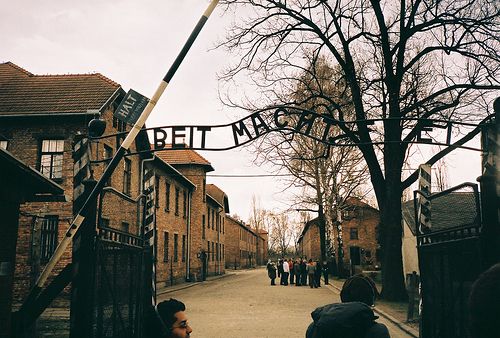

This major symbol of the Holocaust is one of the top must-sees during any tour to Poland. In fact, it is the most frequently visited memorial in Poland. On the grounds of the former concentration camp, you can see barracks, fences, fortified walls with barbed wire, wooden watchtowers, and railway ramps. The museum also includes exhibitions with personal belongings of the murdered prisoners, such as suitcases, glasses, or shoes. Auschwitz I and Auschwitz II-Birkenau are listed on the World Heritage List as evidence of the dehumanization and mass extermination of Jews.
How to visit Auschwitz-Birkenau?
The best overnight base for the Auschwitz visit is the city of Krakow, located just one hour away from the memorial. One way to visit it is by booking a shuttle bus. If you do not want to worry about booking entry tickets on your own (it is pretty difficult, as they sell out well in advance), we suggest booking an all-inclusive Auschwitz tour with a transfer, tickets, and guided tour. If you are staying in the Polish capital, we definitely recommend booking a day trip from Warsaw by car or minibus, as there are no direct trains or buses between Warsaw and Auschwitz. With an all-inclusive Auschwitz tour, you will be picked up and dropped off at your hotel in Warsaw, and taken to Auschwitz Museum by an English-speaking driver. The journey by car takes around 4 hours, but you will have the amazing opportunity to see the beautiful Polish landscape. The driver can slightly change the route to go through the villages. Also, traveling by car you can also stop at "Anlage Mitte" in Konewka - another Nazi shelter and command center from World War 2. It is 380-meter long and was intended for sheltering a train of the staff officers. On the site, you can see miniatures of German shelters and baggage trains, military equipment, guns and vehicles from World War 2.
Read more about convenient ways to visit Auschwitz from Warsaw in our article about how to visit Auschwitz from Warsaw.
Other Nazi concentration camps: Treblinka, Lublin-Majdanek, Stutthof
4. Treblinka

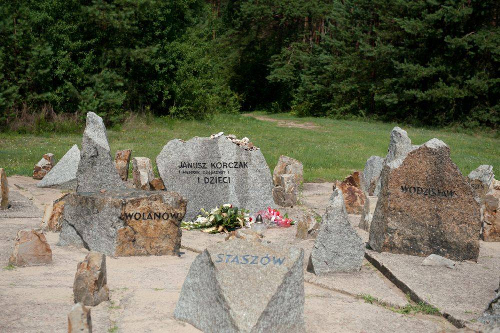
Treblinka is the closest extermination camp to Warsaw, located just a one-hour drive from the capital. It was second only to Auschwitz in the number of Jews killed. The camp was razed to the ground by the retreating Nazis at the end of the war. Nowadays, you can visit Treblinka Museum. Its exhibition presents the history of both camps - the Treblinka II Extermination Camp and the Treblinka I Penal Labor Camp. You can see a miniature of the camps, as well as many objects excavated by archaeologists, for example, barbed wires or personal belongings of the victims. Visitors can also walk on the grounds of the extermination camp. There, you can see a monument commemorating the victims of this place, as well as stones symbolizing the Jewish mitzvah. Behind the monument, there is a rectangle filled with black basalt to mark the site of the crematorium.
How can I visit the Treblinka death camp?
There are no direct trains or buses between Warsaw and Treblinka, the best way is to go there by car. We recommend visiting the camp with the guide, who will explain the meaning of the memorials and the history of this horrifying place. During an all-inclusive Treblinka tour, the guide picks you up at your hotel in Warsaw and tells you about the tragic history of the Holocaust on the way to the site.
5. Majdanek


Located on the outskirts of Lublin, Majdanek is a unique example of a Nazi camp located near the population center. In the Majdanek State Museum, you can visit the partially preserved area of the former concentration camp with barracks, towers, guardhouses, crematoria, bathhouses, and gas chambers. The entry is free of charge, but we recommend visiting the museum with a guide (extra paid). The best overnight base for a visit to Majdanek is, of course, Lublin, but you can also easily reach this city from Warsaw or Krakow by train or car.
6. Stutthof
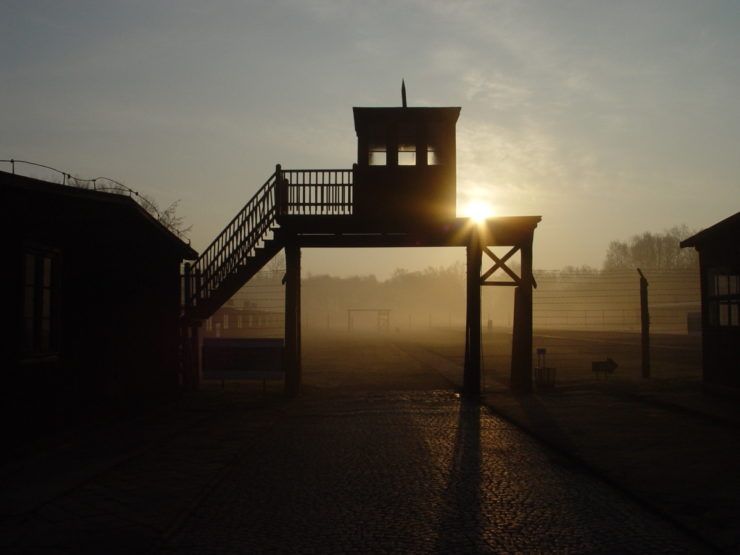
Stutthof was the first Nazi camp on Polish territory and the last to be liberated. On the site, you can see the partially preserved camp, the “Death Gate”, a gas chamber, a brick-built headquarters and garages, and the commandant’s villa. The memorial area also includes a reconstruction of the crematoria. The State Stutthof Museum is located just around 40 minutes away from Gdansk by car, so the capital of Pomerania is a good starting point for a half-day Stutthof tour. The entrance is free of charge, but a visit with the certified museum guide is strongly recommended (it needs to be arranged in advance).
7. Gdansk & Westerplatte


Gdansk is a very important place for Poles and, in fact, for the whole world, for several reasons. Firstly, in the Westerplatte peninsula near the city, the German invasion of Poland began in 1939, which marked the outbreak of World War 2. On September 1st, the German battleship Schleswig-Holstein fired the first salvo. The battle of Westerplatte lasted for a week, despite the overwhelming advantage of the German army. Once Polish troops finally surrendered, the entire area of Westerplatte was completely ruined. Nowadays you can see the impressive Monument of the Coast Defenders on the former grounds of this heroic battle. There is also a small military cemetery with the tombs of the perished soldiers. We suggest combining a visit to the Westerplatte Memorial with Stutthof concentration camp during World War 2 tour from Gdansk. If you would like to learn more stories about the war period, you must visit the Museum of the Second World War. Its main exhibition is located 14 meters underground and depicts everyday life in Poland during World War 2. Inside, you can watch archival photos and videos, listen to stories of witnesses of those events, as well as play with interactive maps presenting famous battles or changes in Poland’s borders during World War 2.

Secondly, Gdansk is globally known as the birthplace of the Solidarity movement (Solidarnosc). With Lech Walesa as its leader, it had a massive contribution to the fall of communism in Europe. You can see the Gdansk Shipyard, where the Polish workers organized numerous protests against the communist regime. Standing next to the Monument to the Fallen Shipyard Workers of 1970 you can hear the tragic story of the heroes who sacrificed their lives for the better future of their children. You can also visit the European Solidarity Centre with an exhibition devoted to the history of the Solidarity trade union and see the changes that took place under its influence in Central and Eastern Europe.
8. Malbork castle

Poland is proud of many glorious palaces and historic strongholds. While visiting our country, you must visit at least one of them. One of the top must-see-castles is definitely Malbork – the biggest brick stronghold in the world! It was built in the 13th century by the Knights of the Teutonic Order, more widely known as the Knights of the Cross. You can visit the castles with a live guide or with audioguides in multiple languages. As the castle complex is pretty huge, you need to dedicate at least 3 hours to explore it properly. This famous landmark is located less than an hour away from Gdansk, which makes it the best overnight base for a Malbork visit. You can also take a day trip to Malbork from Warsaw, in combination with Gdansk sightseeing.
9. Krakow


Krakow was the capital of Poland for many centuries until 1596 when King Sigismund III Vasa moved his official seat to Warsaw. However, to this day Krakow is still known as the Royal City. Here, you can visit the Wawel castle complex – one of the most precious pearls of Poland. It was the formal seat of Polish kings, as well as the venue for royal coronations, weddings, and funerals. In the vaults of the Wawel cathedral, you can see the tombs of most Polish kings, as well as Polish heroes (for example Tadeusz Kosciuszko) and great poets (for example Adam Mickiewicz).


Krakow is also known for its Jewish history and heritage. In the Kazimierz district, you can see many synagogues, as well as Jewish restaurants and cultural venues. In the Podgorze district, located just south of Kazimierz, you can walk on the grounds of the former Jewish ghetto, and a few steps further, you can visit the famous Schindler’s Factory. It is here that Oskar Schindler saved more than 1000 lives from deportation to death camps during World War 2. In the building of the former factory, you can explore exhibitions portraying Jewish history and life in Krakow during the war. Also, in the suburbs of Krakow, you can visit the site of the former Plaszow camp, to which thousands of Krakow Jews were deported. Here, you will see the impressive Monument to the Victims of Fascism.
10. Wielkopolska – Poznan, Gniezno, Biskupin
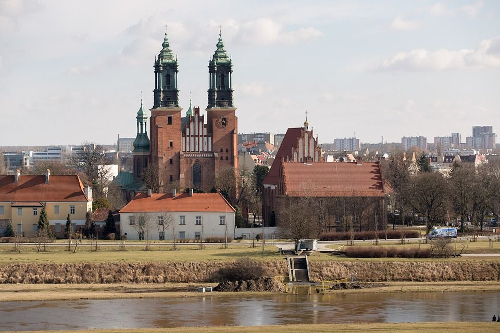
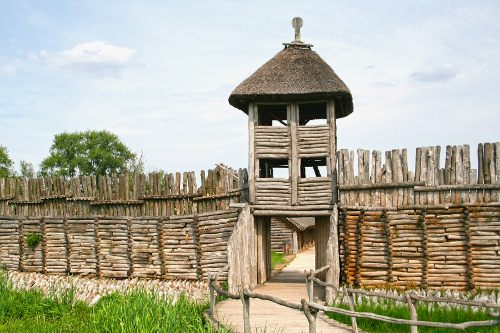
Today’s Wielkopolska region is where the original land of Polans was. Here, in the 10th century, the sovereign from the Piast Dynasty – Mieszko I introduced Christianity to his land. The year 966 is hence considered the official beginning of the Polish state. A few decades later, in 1025 Boleslaw Chrobry was the first Polish ruler to be crowned, which made Poland a kingdom. The first capital of Poland was Gniezno, where you can join many tours about the early medieval beginnings of Poland. You should definitely visit the Gniezno Cathedral with the iconic door depicting the life of St. Adalbert of Prague – the first saint patron of Poland. In Poznan – the capital of Wielkopolska, you can visit the splendid gothic cathedral with tombs of Mieszko I and Boleslaw Chrobry. In visiting the Wielkopolska region, you cannot miss a visit to Biskupin – the reconstructed prehistoric settlement from the Bronze Age, where you can see how people used to live 750 years B.C.
Author: Monika Kwiecień AB Poland Travel
Posted on: 12th April 2021
Photo sources:
AB Poland Travel collection
muzeum1939.pl
wikipedia.org
Blog
Lastest news from AB Poland Travel